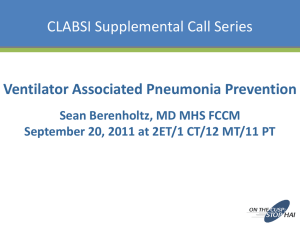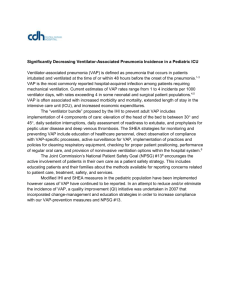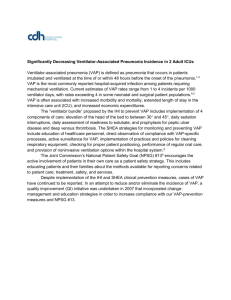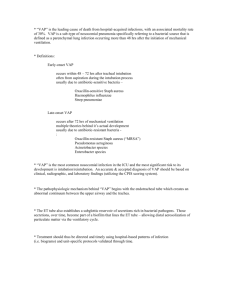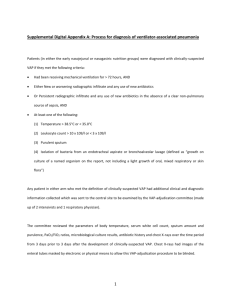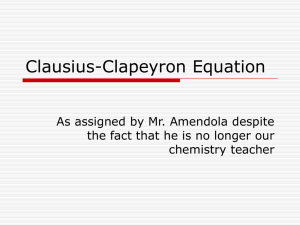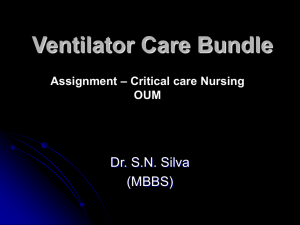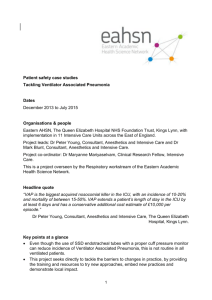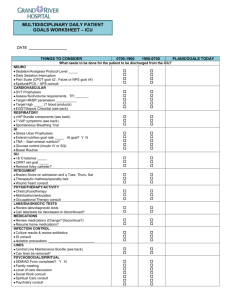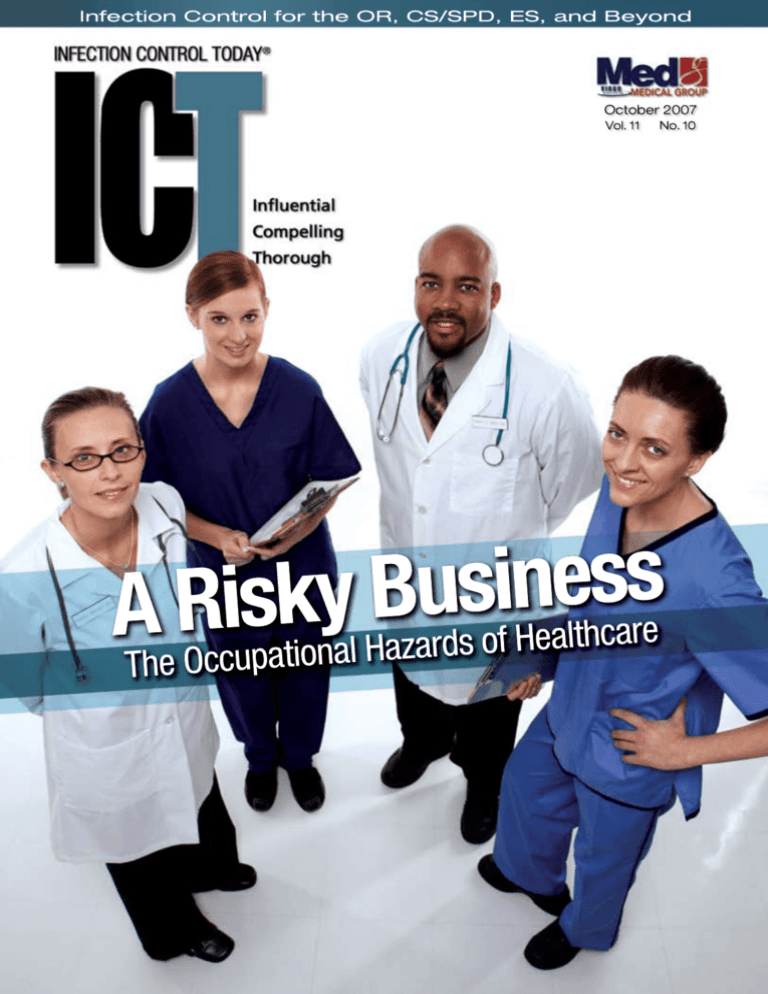
ICT continuing education
Oral Care is Critical Care
The Role of Oral Care in the Prevention of Hospital-Acquired Pneumonia
By Suzanne Pear, PhD, RN, CIC
Most critical care nurses, intensivists and
healthcare epidemiologists have read the statistics
about hospital-acquired pneumonia (HAP) and
ventilator-associated pneumonia (VAP). Pneumonia remains one of the most common causes of
death worldwide. HAP is one of the most common
healthcare-associated (HAI) infections identified in
U.S. hospitalized patients, with 90 percent of the
300,000 annual HAP cases occurring in ventilated
patients (VAP).1 Nine to 27 percent of mechanically
ventilated patients develop VAP, and one episode
of VAP can increase the hospital length of stay by
an average of nine days and the cost of care by
approximately $40,000.2
Sixty percent of healthcare-associated infection
(HAI) deaths are due to HAP/VAP. Most articles on
the subject of HAP/VAP usually begin by quoting
similar facts and figures, in order to gain our attention and remind us how costly HAP/VAP is in terms
of patient lives and healthcare dollars. This is good,
as we need to be reminded and constantly vigilant
in our HAP/VAP prevention efforts.
Another positive impact is that organizations
like the Institute for Healthcare Improvement’s
(IHI) “Lives Saved” campaigns’ VAP bundle3, the
American Thoracic Society (ATS) pneumonia management guidelines2 and the Centers for Disease
Control and Prevention (CDC)’s HAI pneumonia
prevention guideline,4 have provided programs
so that clinicians everywhere understand the
synergistic benefits of bundling evidence-based
practices to prevent HAP/VAP.
We now know there is no single patient-care
intervention that will eliminate HAP/VAP and that
these bundles or guideline components need to
be reliably performed for the full benefits to be
realized. Although not all of the evidence-based
HAP/VAP prevention guidelines recommend the
same strategies, one intervention that has been
recognized as a core or adjunct component of a
pneumonia prevention program is comprehensive
oral care/oral-hygiene. The purpose of this article
is to help connect the clinical dots between the
reliable provision of comprehensive oral care and
HAP/VAP prevention.
What Is Comprehensive Oral Care?
The CDC’s pneumonia guideline discusses the
need to “develop and implement a comprehensive oral-hygiene program …for oropharyngeal
cleaning and decontamination with an antiseptic agent”4 but leaves the specific procedures to
clinicians. Although the IHI’s VAP bundle doesn’t
include oral care as a core measure, it is frequently
included in VAP prevention success stories on its
Web site.5 The American Association of Critical
Care Nurses (AACN), recognizing the urgent need
for clarification, issued a Practice Alert in August
2006 on the issue of “Oral Care in the Critically Ill.”
This document specifies the need to “develop and
implement a comprehensive oral care program for
patients in critical care and acute care settings who
are at high risk for healthcare-associated pneumonia.”6 Such a program should include brushing
teeth, gums and tongue at least twice a day with a
soft pediatric or adult toothbrush and moistening
oral mucosa and lips every two to four hours.
The AACN oral care guideline also recommends using an oral chlorhexidine gluconate
(0.12 percent) rinse twice daily, but only on adult
cardiac surgery patients during their perioperative period.6 As part of VAP prevention, the
Association for Professionals in Infection Control
and Epidemiology (APIC) exhorts clinicians to
make “patient oral hygiene standard practice”
for ventilated patients.7
Aligning with the CDC, this clinical guidance
document describes oral hygiene as consisting
of “frequent tooth brushing, oral suctioning
and swabbing of the mouth with antiseptic
agents.”7 According to this healthcare worker
(HCW) education publication, making routine
oral hygiene a standard patient care intervention
has been found to reduce the incidence of VAP
by 57.6 percent.
Figure 1. Sites of bacterial attachment in the mouth
Why Comprehensive Oral Care
is Necessary to Prevent VAP
Normal Oral Flora
In order to appreciate why oral care is essential
for VAP prevention, it is necessary to understand
the mouth of a healthy adult as well as the
changes that occur in the mouth of the critically
ill patient soon after admission into the healthcare setting. Most oral bacteria are considered
to be part of the patient’s normal flora and may
consist of up to 350 different species. Various
organisms tend to colonize different surfaces in
the mouth. For example, Streptococcus mutans,
Streptococcus sanguis, Actinomyces vicosus and
Bacteroides gingivalis mainly colonize the teeth
while Streptococcus salivarius mainly colonize the
dorsal tongue. Another common commensal,
Streptococcus mitis, is found on both buccal and
tooth surfaces.8 These flora are usually considered
low-level pathogens which may take years or
decades to produce clinically significant disease.
Role of Saliva
Another important component of oral health
is the continuous production of saliva, which
is essential to keeping the mouth and its components clean and moist. Saliva is a mixed fluid
secreted predominantly from the parotid, submandibular and sublingual glands. It provides
a number of important functions such as washing food debris and unattached microorganisms
from the mouth. In addition, saliva contains a
number of immune substances such as immunoglobulin A which obstructs microbial adherence
in the oral cavity and lactoferrin which inhibits
bacterial infection in the healthy individual.9 The
dorsal surface of the tongue often traps residual
debris not removed during swallowing and is
known to harbor millions of organisms. Routine
tongue cleaning is not generally performed by
either patients or care providers.10
Oral Environment of Critically Ill
The oral flora of critically ill adults differs
from that of healthy adults and contains organisms that can rapidly cause pneumonia. Within
48 hours of admission, the composition of the
oropharyngeal flora of critically ill patients undergoes a change from the usual predominance of
gram-positive streptococci and dental pathogens
to predominantly gram-negative organisms, constituting more virulent flora, including pathogens
that can cause HAP/VAP within hours or days.11
Also, increased levels of proteases in the oral
secretions of critically ill patients remove from
their epithelial cell surfaces, a glycoprotein substance called fibronectin. Normally, fibronectin
is present on cell surfaces and acts as a host
defense mechanism by blocking pathogenic
bacterial attachment to oral and tracheal mucus
membranes. This depletion of fibronectin in the
criticall ill allows cell receptor sites to replace
normal flora with virulent pathogens such as
Staphylococcus aureus and different strains of
gram negative bacteria, including Pseudomonas
aeruginosa and Acinetobacter on buccal and
pharyngeal epithelial cells.8
If the critically ill or intubated patient does not
receive effective, comprehensive oral hygiene,
then dental plaque and hardened bacterial depos-
ICT continuing education
its may develop on the teeth within 72 hours.
This is followed by emerging gingivitis, gum
inflammation, infection and a subsequent shift
from primarily Streptococcus and Actinomyces
spp. to increasing numbers of aerobic gram-negative bacilli.10 Since adhesion to a surface in the
mouth is important for the continued existence
and proliferation of organisms, bacteria which
attach to the tooth surface gradually coalesce to
produce a biofilm and after further development,
lead to the formation of dental plaque.9
Xerostomia and Mucositis in the
Critically Ill Patient
Xerostomia is dry mouth and mucositis means
oral inflammation. Studies by Dennesen et al.
have documented a nearly absent salivary flow
in intubated sedated ICU patients which can be
explained by several circumstances such as the
severity of the disease resulting in intubation and
admission to the ICU, lack of normal oral intake,
fluid balance disturbances, extended use of morphine required because of controlled mechanical
ventilation or pain management.12
Apart from the inadequate flow, the saliva is
not distributed through the oral cavity in a supine
sedated patient and severe xerostomia, severely
reduced salivary flow and dry mouth, is therefore
generally present in ICU patients. As the mucus
membranes of the mouth dry out, the tissues
become inflamed. A severe reduction of salivary
flow and subsequent xerostomia and mucositis
may result in increased oropharyngeal colonization with respiratory pathogens. As mucositis or
oral inflammation increases in the hospitalized
and ventilated patient’s mouth, the level of oral
bacteria increases as well. The greater the level
of oral bacteria, the greater the amount of biofilm that attaches to the patient’s teeth. Allowing
build-up of biofilm and resultant dental plaque,
if not removed, increases the bacterial load in
oropharyngeal secretions. Given the fact that all
patients aspirate secretions, even non-ventilated
patients, the greater the amount and microbial
contamination of aspirated secretions, the more
likely that lung infection, i.e., HAP/VAP will occur.
Therefore, a critical component of any evidencebased HAP or VAP prevention bundle must be the
prevention of plaque formation by ensuring that
patients perform or receive thorough oral care,
especially mechanical debridement of biofilm
and plaque at least twice daily.13 Comprehensive
oral care interventions should focus on plaque
removal and stimulation of salivary flow.14
The Pathway to VAP
Why are ventilated patients more susceptible
to pneumonia? Two words – endotracheal (ET)
tube. The ventilated patient’s normal defenses are
hampered, bypassed, blocked or disabled during
endotracheal tube-assisted mechanical ventilation
by the physical presence of the assistive-breathing device as well as by medications used to keep
these patients sedated.15 The presence of the ET
Figure 2. The Pathway to VAP
tube hampers natural host protection and secretion clearance mechanisms. It bypasses normal
air filtration and physical capture of microorganisms and particulates. The ET tube also blocks the
mucociliary clearance mechanism as well as disables the cough reflex and inhibits phagocytosis
in the alveoli. Its very presence initiates “foreign
body” reaction in the tracheal tissues, increasing
secretory and inflammatory responses.
In addition, the ET tube acts as a direct
conduit for pathogen access into the lungs,
allowing a biofilm or “slime layer” to form that
allows microbes to multiply on its surface, which
can then dislodge and drop into the lungs.
Over pressure of the ET tube cuff can damage
(necrose) the tracheal wall, potentially causing long term damage as well as providing an
inflamed site for bacteria migration and growth.
Contaminated secretions or dislodged biofilm
particles fall into the lungs directly through the
ET tube or around the ET tube cuff. The lungs
become contaminated with pathogenic microorganisms which may additionally proliferate
within the lung tissue. This cycle of contamination, aspiration and pathogen multiplication
continues. If these pathogenic microorganisms
overwhelm the body’s antibacterial defenses,
the patient develops pneumonia.
The Recommended Interventions and
Rationales of a Comprehensive Oral
Care Protocol
Recommended oral care interventions for
all hospitalized patients16
Written Protocol and Training
• Intervention: Written oral care protocol
and training should be in place.
• Rationale: Policy is designed to provide
a standard of care which should be
reinforced in training and should allow for
consistent care of all patients.
Initial Assessment
• Intervention: Conduct an initial admission
assessment of the patient’s oral health and
self-care deficits.
• Rationale: Assessment allows for initial
identification of oral hygiene problems.
Dental Plaque Removal
• Intervention: Use a small, soft toothbrush
to brush teeth, tongue and gums at least
twice daily to remove dental plaque. Foam
swabs or gauze should not be used, as
they are not effective tools for this task.
• Rationale: Dental plaque, identified as a
source of pathogenic bacteria associated
with respiratory infection, requires
mechanical debridement from tooth,
tongue and gingival surfaces.
Toothpaste
• Intervention: Use toothpaste which
contains additives that assist in the
breakdown of mucus and biofilm in the
mouth.
• Rationale: Additives such as sodium
bicarbonate have been shown to assist
in removing debris accumulations on oral
tissues and teeth.
Antiseptic Mouth Rinse
• Intervention: Use an alcohol-free, antiseptic
rinse to prevent bacterial colonization of
the oropharyngeal tract.
• Rationale: Mouthwashes with alcohol cause
excessive drying of oral tissues. Hydrogen
peroxide and CHG-based rinses have been
shown to assist in removing oral debris as
well as provide antibacterial properties.
Moisturizer
• Intervention: Use a water-soluble
moisturizer to assist in the maintenance of
healthy lips and gums at least once every
two hours.
• Rationale: Dryness and cracking of
oral tissues and lips provide regions for
bacterial proliferation. A water-soluble
moisturizer allows tissue absorption and
added hydration.
Avoid Lemon Glycerin Swabs
• Intervention: Avoid using lemon-glycerin
swabs for oral care to moisten oral mucosa.
• Rationale: Lemon-glycerin compounds are
acidic and cause drying of oral tissues.
Assessment of Oral Cavity16
• Intervention: Conduct an initial admission
as well as daily assessment of the lips, oral
tissue, tongue, teeth, and saliva of each
patient on a mechanical ventilator.
• Rationale: Assessment allows for initial
identification of oral hygiene problems and
for continued observation of oral health.
Elevate Head
• Intervention: Keep head of bed elevated
at least 30 degrees, and position patient
so that oral secretions pool into the
buccal pocket; especially important during
feeding, brushing teeth, etc.
• Rationale: Elevation prevents reflux
and aspiration of gastric contents; oral
secretions may drain into the subglottic
area where they can become rapidly
colonized with pathogenic bacteria.
ICT continuing education
Oral and Orotracheal Suctioning
• Intervention: Suction patient’s
mouth and oropharynx routinely and
as indicated by patient’s secretion
production, using either continous
subglottic suctioning or manual method.
Do not use same catheter to suction
both mouth and trachea.
• Rationale: Minimize aspiration of
contaminated secretions into lungs.
Does Reduction of Oral Microbial
Colonization and Dental Plaque Really
Reduce VAP?
The oral care intervention project reported by
Garcia and colleagues helps connect the clinical
dots between dental plaque reduction and VAP
prevention.17 This study compared patients who
received standard oral care (which consisted of
yankauer suctioning and glycerin swabs for mouth
care) to patients who received comprehensive oral
care. Comprehensive oral care included daily oral
assessment, teethbrushing, oral and orotracheal
suctioning, hydrogen peroxide rinse, oral mucosa
moisturizer, and use of a covered yankauer. The
results of the study were that the group of ventilator patients who received the comprehensive
dental intervention had 42 percent fewer episodes of pneumonia. The researchers concluded
that careful oral assessment and improved oral
care reduces contaminated aspirates and results
in significant reduction in the incidence of subsequent VAP.
Are Toothbrushes Better
Than Foam Swabs for Plaque Removal?
To answer this question, Pearson and
Hutton conducted a time-series, cross-over
controlled trial with 34 volunteers which studied plaque accumulation and removal with
the two oral care tools.18 The study found
that toothbrushes performed substantially
better than foam swabs in removing plaque
from sheltered areas of teeth. The researchers
concluded that nurses should be educated on
toothbrushing skills and need to be supported
in developing oral care protocols, practice and
assessment abilities.
Can Chlorhexidine Gluconate (CHG)
Mouth Rinse Take the Place of
Toothbrushing?
A large number of studies have reviewed
the effect of CHG mouth rinse on prevention of VAP, with conflicting results.(13,19-21)
Two meta-analyses of these studies report that
although CHG may reduce the incidence of VAP,
it doesn’t reduce time on the ventilator or lower
the mortality rate.(22,23) This confusing finding
may be the result of a number of factors, the
most relevant of which may be that CHG is not a
very effective antibacterial agent against gramnegative or multiresistant bacteria, which are
the pathogens most commonly associated with
VAP.(24) Considering these data, it would seem
that at best, CHG mouth rinse should be used as
an adjunct to mechanical plaque removal with a
toothbrush, as opposed to replacing this essential component of comprehensive oral care.
What is the Current Practice of Oral
Care in the Adult ICU?
A number of studies in the critical care literature
document the significant variability in the quality and quantity of oral care provided to patients.
In 1999, a study investigated how oral care was
being performed in the adult ICU. The reseachers identifed that nurses had not been formally
trained in assessing oral status of patients in ICUs
and no formal protocol for mouth care existed.
Most nurses used a foam swab dipped in water
or mouthwash to provide mouth care to patients,
but the method and frequency “varied from nurse
to nurse and patient to patient.”(25) As part of
the study, the nurses then received training on oral
assessment plus implementation of a formal oral
care protocol, which resulted in marked improvement in their patients’ oral health.
In 2004, researchers from the University of
Louisville Schools of Nursing and Dentistry surveyed more than 550 nurses working in more
than 100 ICUs about their oral care knowledge
and practices.(26) Ninety-two percent of the
nurses reported that they believed oral care to be
important, but only 20% used toothbrushes and
toothpaste when providing oral care. Almost half
of those surveyed said they needed better oral
care supplies and wanted more evidence-based
education about oral care.
An interventional study which was reported in
2005 monitored baseline oral care provided to 139
mechanically ventilated patients at 5 different hospitals and 8 ICUs over a 2 month period.(27) The
observers noted that none of the ICUs had formal
protocols and none of the patients had their mouths
assessed, their teeth brushed, lips or mouths moistened, oropharynx suctioned or suction tubing
changed. Nurses were still using either suction or
non-suction, moistened swabs to clean patients’
mouths. Two of the ICUs had suction toothbrushes
available, but staff rarely used them. Additionally,
nurses reported providing oral care more frequently
than was documented in the medical record. The
intervention, which consisted of a multi-faceted
education program, including a standardized, comprehensive protocol and adequate oral care tools,
resulted in marked increase in the amount and frequency of oral care provided.
More recently, a study published in January
2007 reported the findings from a survey of 1200
nurses on their compliance with the CDC’s VAP
prevention guidelines.(28,4) Only 56% of the
nurses reported having a formal oral care protocol,
36% reported performing subglottic suctioning
and 34% routinely maintained patients’ head
of bed elevated above 30o. Less than 40% of
survey respondents reported knowing their unit’s
VAP rates or likely causative organisms.
What Are the Barriers to Reliable
Comprehensive Oral Care in the ICU?
Another large survey of ICU nurses investigated the factors affecting the quality of oral
care being provided in ICUs.(29) This study is
important because it identified, from the nurse’s
perpectives, what may be preventing them from
providing optimal oral care. ICU nurses reported
still needing oral care education. They also said
that they have insufficient time to provide oral
care, have trouble seeing oral care as a priority
and continue to view oral care as an unpleasant
task. The reseachers concluded that improving
oral care in ICUs is a multi-layered task – certainly
not as simple as it appears on the surface. Their
recommendations for improvement included the
need to reinforce proper oral care through education, de-sensitize nurses to the often-perceived
unpleasantness of cleaning patients’ mouths and
finally, the importance of monitoring compliance
while continuing to identify additional barriers to
care as they emerge.
Conclusion
HAP and VAP continue to be the most lethal
and likely causes of death attributable to healthcare-associated infections. These infections are
very costly in terms of lives lost and healthcare
dollars wasted. National published guidelines for
HAP/VAP prevention, which rely upon published
research evidence, consider comprehensive oral
care to be essential care for prevention of pneumonia in the hospitalized patient. The rapid,
potentially pathologic changes in hospitalized
and ventilated patients’ oral environment make
oral care a critical component of any HAP/VAP
prevention bundle. Optimal oral care for pneumonia prevention is not the comfort care that
historically had been provided, e.g., oral suctioning with a yankauer and use of moistened
cotton or foam swabs.
Comprehensive oral care should focus
on plaque removal and stimulation of salivary flow. However, similar to hand hygiene,
compliance with consistent provision of comprehensive oral care has not been as straight
forward as one would hope. The ability to
provide oral care in the ICU setting is hampered by a number of factors including the
competing priorities in a turbulent ICU for
nurses’ care and attention. It is essential that
all nurses receive evidence-based education
on the patient care practices which are necessary for improving patient outcomes. When
nurses (and their hospital administrators) truly
understand the criticality of providing comprehensive oral care to all patients, finding the
time to provide oral care will no longer be
problematic. Patients will then receive comprehensive oral care as needed and HAP/VAP
rates will approach zero tolerance.
Comprehensive oral care really does
make a difference! Oral care is critical care
for all patients.
ICT
Reproduced with permission from Infection Control Today, October 2007 . For electronic usage only.
Not to be printed in any format. ©2007 Virgo Publishing. All Rights Reserved.

